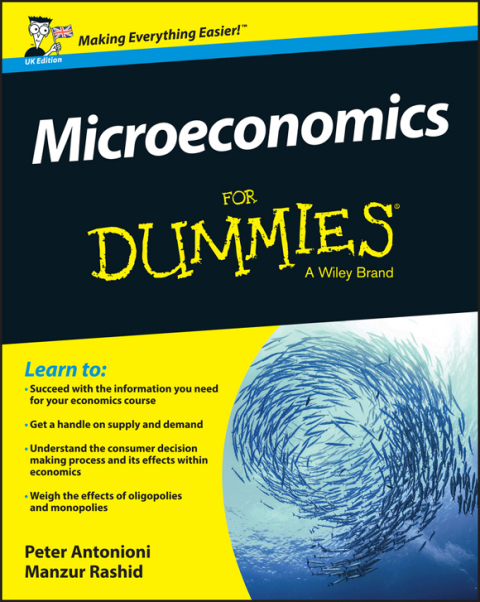Description
Efnisyfirlit
- Cover
- Introduction
- About This Book
- Foolish Assumptions
- Icons Used in This book
- Beyond the Book
- Where to Go from Here
- Part I: Getting Started with Microeconomics
- Chapter 1: Discovering Why Microeconomics Is a Big Deal
- Peering into the Economics of Smaller Units
- Making Decisions, Decisions and More Decisions!
- Understanding the Problems of Competition and Co-operation
- Investigating Why Markets Can Fail
- Chapter 2: Considering Consumer Choice: Why Economists Find You Fascinating!
- Studying Utility: Why People Choose What They Choose
- Modelling Consumer Behaviour: Economic Agents
- Pursuing Preferences and Investigating Indifferences
- Chapter 3: Looking at Firm Behaviour: What They Are and What They Do
- Delving into Firms and What They Do
- Considering How Economists View Firms: The Black Box
- From Firm to Company: Why People Form Limited Liability Companies
- Part II: Doing the Best You Can: Consumer Theory
- Chapter 4: Living a Life without Limits
- Eating Until You’re Sick! Assuming that More Is Always Better
- Deciding How Low You’ll Go! Marginal Utility
- Chapter 5: Considering the Art of the Possible: The Budget Constraint
- Taking It to the Limit! Introducing the Budget Constraint
- Getting the Biggest Bang for Your Buck
- Putting the Utility Model to Work
- Chapter 6: Achieving the Optimum in Spite of Constraints
- Investigating the Equilibrium: Coping with Price and Income Changes
- Dealing with Price Changes for One Good
- Discerning a Consumer’s Revealed Preference
- Decomposing Income and Substitution Effects
- Part III: Uncovering the Alchemy of Firms’ Inputs and Outputs
- Chapter 7: Working with Different Costs and Cost Curves
- Understanding Why Accountants and Economists View Costs Differently
- Looking at a Firm’s Cost Structure
- Relating Cost Structure to Profits
- Chapter 8: Squeezing Out Every Last Drop of Profit
- Asking Whether Firms Really Maximise Profits
- Going Large! The Goal of Profit Maximisation
- Slimming Down! Minimising Costs
- Chapter 9: Supplying the Demanded Information on Supply and Demand
- Producing Stuff to Sell: The Supply Curve
- Giving the People What They Want: The Demand Curve
- Identifying Where Supply and Demand Meet
- Chapter 10: Dreaming of the Consumer’s Delight: Perfect Competition
- Viewing the ‘Perfect’ in Perfect Competition
- Putting the Conditions Together for the Perfectly Competitive Marketplace
- Examining Efficiency and Perfect Competition
- Part IV: Delving into Markets, Market Failure and Welfare Economics
- Chapter 11: Stepping into the Real World: Oligopoly and Imperfect Competition
- Outlining the Features of an Oligopoly
- Discussing Three Different Approaches to Oligopoly
- Making Your Firm Distinctive from the Competition
- Chapter 12: Appreciating the Fundamental Theorems of Welfare Economics
- Getting the Welfare Back into Welfare Economics
- Understanding Why Partial Equilibrium Isn’t Enough
- Trading Your Way to Efficiency with Two Fundamental Theorems
- Chapter 13: Controlling Markets with a Monopoly
- Entering the World of the Monopoly
- Counting the Costs of Monopolies
- Tackling Monopolies in the Real World
- ‘You Make Me Feel Like a Natural Monopoly’
- Chapter 14: Examining Market Failure: Pollution and Parks
- Coming to Grips with Externality: Too Much of a Bad Thing
- Making the Market Produce What It Won’t: Public Goods
- Chapter 15: Understanding the Dangers of Asymmetric Information
- Seeing the Effects of Asymmetric Information
- Changing Your Behaviour because of Asymmetric Information
- Part V: Thinking Strategically: Life Is Just a Game!
- Chapter 16: Playing Games with Economic Theory
- Setting the Game: Mechanism Design
- Locking Horns with the Prisoners’ Dilemma
- Looking at Collective Action: The Stag Hunt
- Annoying People with the Ultimatum Game
- Getting out of the Dilemma by Repeating a Game
- Chapter 17: Keeping Things Stable: The Nash Equilibrium
- Defining the Nash Equilibrium Informally
- Looking for Balance: Where a Nash Equilibrium Must Apply
- Applying the Nash Equilibrium in Economics
- Chapter 18: Knowing How to Win at Auctions
- Spotting Different Kinds of Auction
- Bidding for Beginners
- Suffering from the Winner’s Curse
- Chapter 19: Deciphering the Signals: Threats and Benefits
- Refining the Nash Equilibrium to Deal with Threats
- Responding to Positive Economic Signals
- Part VI: The Part of Tens
- Chapter 20: Meeting Ten Great Microeconomists
- Alfred Marshall (1842–1924)
- Joseph Alois Schumpeter (1883–1950)
- Gary S Becker (1930–2014)
- Ronald Coase (1910–2013)
- Elinor Ostrom (1933–2012)
- William Vickrey (1914–96)
- George Akerlof (born 1940)
- James Buchanan (1919–2013)
- William Baumol (born 1922)
- Arthur Cecil Pigou (1877–1959)
- Chapter 21: Ten Top Tips to Take Away
- Respecting Choice
- Pricing a Good: Difficult but not Impossible
- Competing on Price or Quality
- Seeking Real Markets’ Unique Features
- Beating the Market in the Long Run is Very Difficult
- Knowing a Tradeoff Always Exists Somewhere
- Arguing about the Next Best Thing
- Using Markets Isn’t Always Costless
- Believing that Competition is Good – Usually
- Getting Co-operation and Organisation in the World
- Glossary
- About the Authors
- Cheat Sheet
- Advertisement Page
- Connect with Dummies
- End User License Agreement






